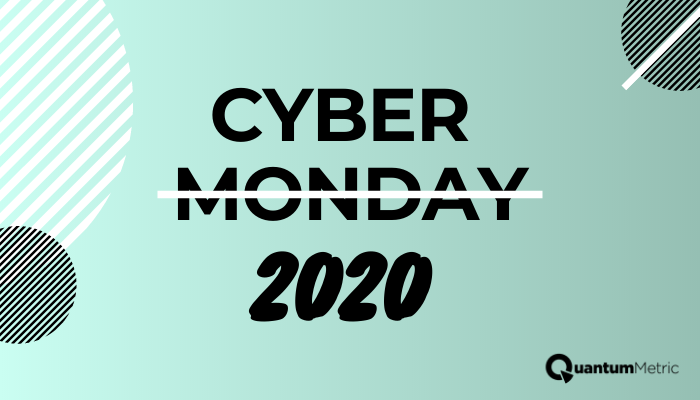Did Cyber Monday transition to Cyber 2020?

Black Friday and Cyber Monday Spending in 2020
Black Friday and Cyber Monday have passed, and the data is in: Quantum Metric captured 140M+ sessions and surfaced that online spending on Black Friday blow Cyber Monday spending expectations out of the water.
Unsurprisingly, many consumers skipped their in-person trips to the mall and continued the tradition of Black Friday shopping from the comfort of their homes. In fact, much of the online spending that experts predicted would occur on Cyber Monday actually shifted to Black Friday.
Total online spending on Black Friday this year surged to $9 billion, shattering previous records. According to a report from Adobe Analytics, online spending on Black Friday increased 21.6% from last year, up from $7.5 billion in total online spending on the same shopping day last year.
Retailers, however, were seemingly underwhelmed with Cyber Monday sales. Ahead of the holiday weekend, Adobe Analytics forecasted that Cyber Monday shopping would reach $12.7 billion in spending in 2020. Last year, Cyber Monday broke records by reaching $9.4 billion in total spending.
This past Cyber Monday may have been the biggest e-commerce day ever, with consumers spending a collective $10.8 billion, but total online spending fell almost $2 billion dollars short of expectations.
Some retailers extended their Cyber Monday sales a few days longer. Others are planning to offer weeks of deals in December, to make up for the fact that shoppers will be stuck at home as coronavirus cases continue to rise.
Retailers shouldn’t over emphasize one season or day, even if Cyber Monday is the busiest online shopping day of the year. Preferably, retailers should focus on continuously improving their online customer experience throughout the holiday season so that they can meet the ever-changing demands of their customers.
The bottom line? Companies can no longer focus most of their yearly efforts on Black Friday and Cyber Monday. Instead, the holiday shopping season will continue to last for weeks. Now more than ever before, retailers need to remain on their toes, anticipating any obstacles and identifying new business opportunities.
How Quantum Metric clients experienced Black Friday and Cyber Monday
Here at Quantum Metric, we compared Black Friday and Cyber Monday data for the same group of retail brands from last year to this year.
Internal data from Quantum Metric clients suggests that online spending on Black Friday crushed Cyber Monday. In comparison to Cyber Monday, Black Friday saw 22% higher online traffic, a 19% increase in overall checkout revenue, and a 29% increase in order volume.
Take a quick look at some other important data points.
- Overall traffic across mobile and desktop devices, as measured by session count, on Black Friday increased 11% this year. Similarly, overall checkout revenue increased across both mobile and desktop devices, for a total increase of 38%.
- Overall order volume was up 19% from last year, while average order value saw a 37% increase. Of particular note is that the average order value on mobile went from $169.30 in 2019 to $249.39 in 2020, a whopping 47% increase that suggests online shoppers are routinely making larger purchases on their mobile devices.
- Given the increase in online spending, it’s not surprising that the overall number of website errors also increased a staggering 39% year over year.
Preparing for the future of online shopping
The US government plans to start distributing vaccines for the coronavirus later this month, but experts are saying that herd immunity might not occur until 2022, per a McKinsey report.
With continued lockdowns and waves, companies can’t afford to not be agile, and being agile means that companies can easily adapt to sudden changes.
Traditionally, engineering and product teams initiate a code freeze to prepare for periods where website traffic will be highest, such as on days like Black Friday and Cyber Monday. For retailers in particular, code freezes are intended to help maintain stability when online spending reaches its peak.
One goal of the code freeze is to establish a stable user experience for a website and mobile app weeks ahead of the holiday traffic surge. Once locked into place, teams avoid implementing any code changes—major or minor—until after the holiday traffic subsides.
But when the pandemic struck back in March, we quickly learned that peak website traffic can occur on any day. According to our internal data, retail websites can expect traffic to double or triple on a regular basis while Americans are sheltering at home.
It’s not surprising, then, that some industry leaders have initiated the conversation about doing away with code freezes. The only way to prepare for the uptick in online traffic is to always be anticipating an increase in customer demand.
The fact of the matter is that businesses must continuously be listening to their customers and adapting on a real-time basis.
Continuous Product Design (CPD) takes on the code freeze
One question that continues to emerge from conversations with Quantum Metric customers and prospects is this: Is the code freeze still relevant?
At Quantum Metric, we believe that it’s in the customer’s best interest to always be iterating and adapting, even during the busiest shopping periods.
This is why the Quantum Metric team advocates for Continuous Product Design (CPD), a customer-defined and quantified approach to building better digital products. Continuous Product Design is all about using data-driven design methods to identify technical, money-losing errors, as well as crucial UX design flaws that tend to go unnoticed by traditional monitoring platforms.
Companies that don’t continuously iterate based on customer data run the risk of slowing down the development process in the long run. Rather than embrace the code freeze, retailers can drive revenue by spending the holiday shopping season testing, iterating, and experimenting. Otherwise, they’re leaving money on the table.
Unlike Continuous Product Design, code freezes make it impossible to adapt to changing customer behavior, offering less long-term stability. Longer freezes also mean bigger backlog build ups, which can interfere with the integration and testing process. When January rolls around this can lead to teams prioritizing the backlog, not what customers need here and now.
It’s also common for developers to ship risky code under pressure. To make deadlines, teams cut corners, conduct fewer tests, skip manual testing all together, or worse—introduce new bugs.
Thanks to the pandemic, surges in website traffic are occurring more frequently across the board. This means that the online customer experience needs to be top of mind, never just a second thought. Any day could become the new Cyber Monday.
By putting the customer experience first, and by continuing to monitor and track how customers interact with e-commerce sites and mobile apps, retailers can stay ahead of the curb by anticipating problems long before they occur.
And retailers that continuously adapt to their customers will reap the benefits of delivering a user experience that customers want and need—a user experience that keeps customers coming back for more.







